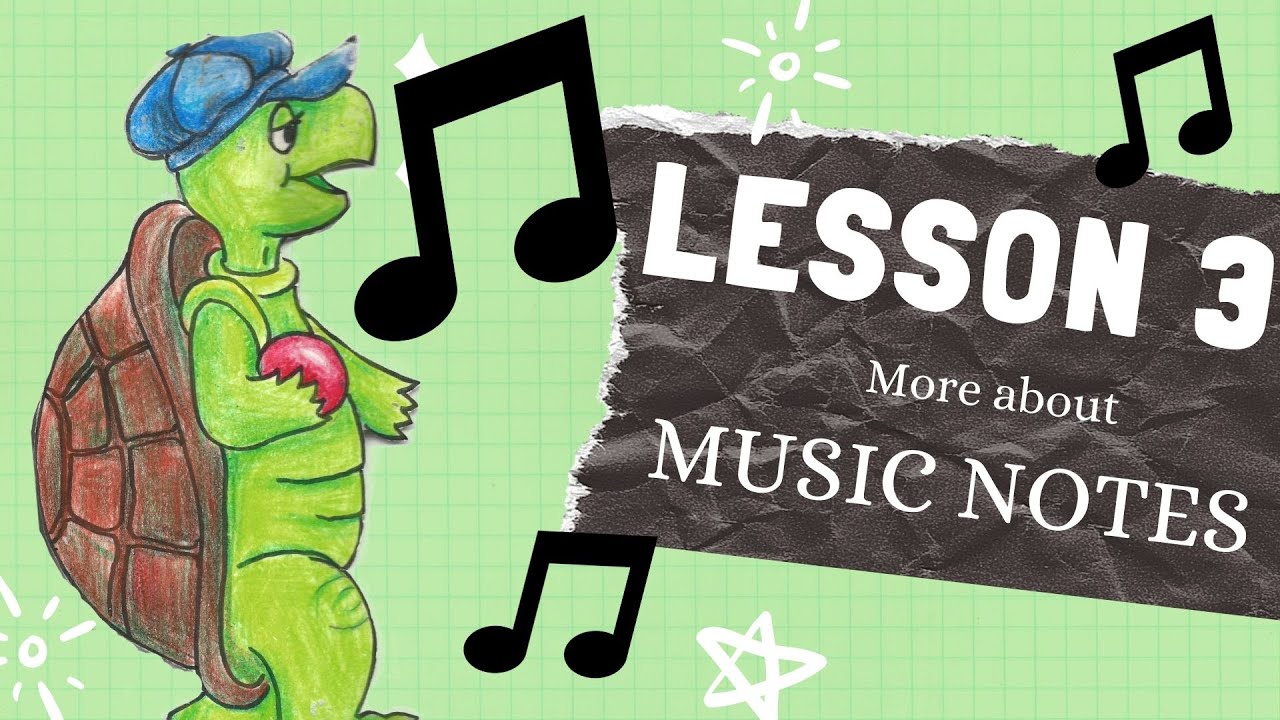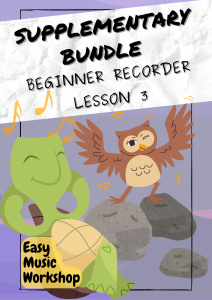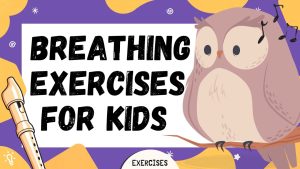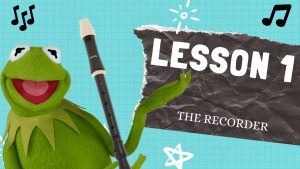Hi there,
in this post I reveal how I introduce my Music students to the eighth notes; probably their favourite, because… well, most children cannot resist the opportunity to run. In LESSON 3 they get the opportunity to run, and not only with their fingers on the recorder.
This lesson follows an introductory lesson to note values, Beginner Recorder LESSON 2, which you will find on YouTube here. I also have a blog post on how I use this video to teach note values to young beginner recorder students in the classroom here. But now let’s move on to revising the whole note (semibreve), half notes (minims) and quarter notes (crotchets) with our music students and introducing the eighth notes (or quavers).
INTRODUCTION:
At the beginning of the “EMW Beginner Recorder LESSON 3” Miss Piggy and I refer back to the YouTube video “Mickey Mouse – William Tell vs Turkey in the Straw – by Orlan Charles”. So, if your recorder students haven’t seen it yet, then I would recommend that the lesson begins with this video.
The next step would be to watch the “EMW Beginner Recorder LESSON 3”. Let the kids join in with the owl breathing exercise at 2:50 minutes into the video.
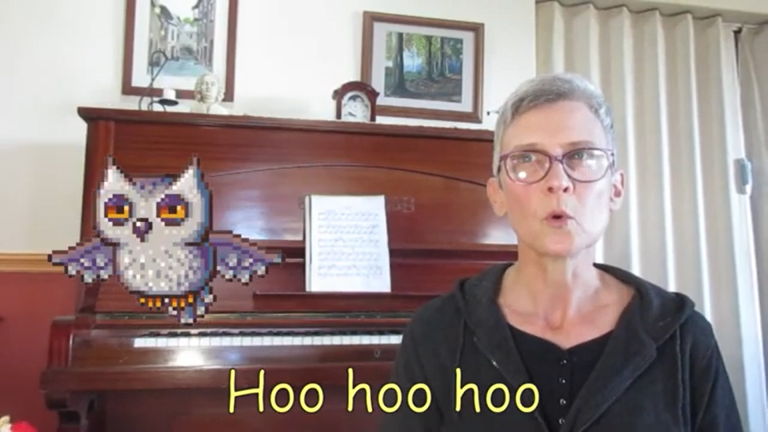
MOVING TO THE DIFFERENT NOTE VALUES:
At the end of the story of the Tortoise family, when the different note values are shown on the screen, pause the video, revise which movement went with which note value and let the children move to these note values. For this section of the lesson, it is helpful to have pictures of the various Tortoise Family members and the note value cards to hold up for the children to make the visual connection. These are available in the Supplementary bundle for the EMW RECORDER LESSON 3.
For example, the teacher can demonstrate how to move like the Grandpa note (Whole note) by bending over and holding on to the aching back and pretending that the recorder is the top of his walking stick. Every step should be four counts long and can be counted out with a wobbly Grandpa voice: “One, two, three, four!”. Let the children move like Grandpa Tortoise towards the screen (smart board or white board) and back to their seats.
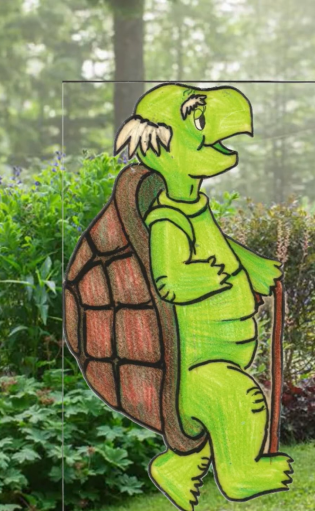

When they are back at their seats demonstrate how to move like Grandma Tortoise (Half note). She holds her hands behind her back as she slowly strolls through her garden with a step-swing movement. This step-swing movement involves one step forward with one foot, then let the other foot swing forward on the second beat and then take the next step. The “Grannies” can say: “Slow-ly! Slow-ly! Step-swing, step-swing! One-two, one-two…”, while moving towards the screen and then back to their chairs again.
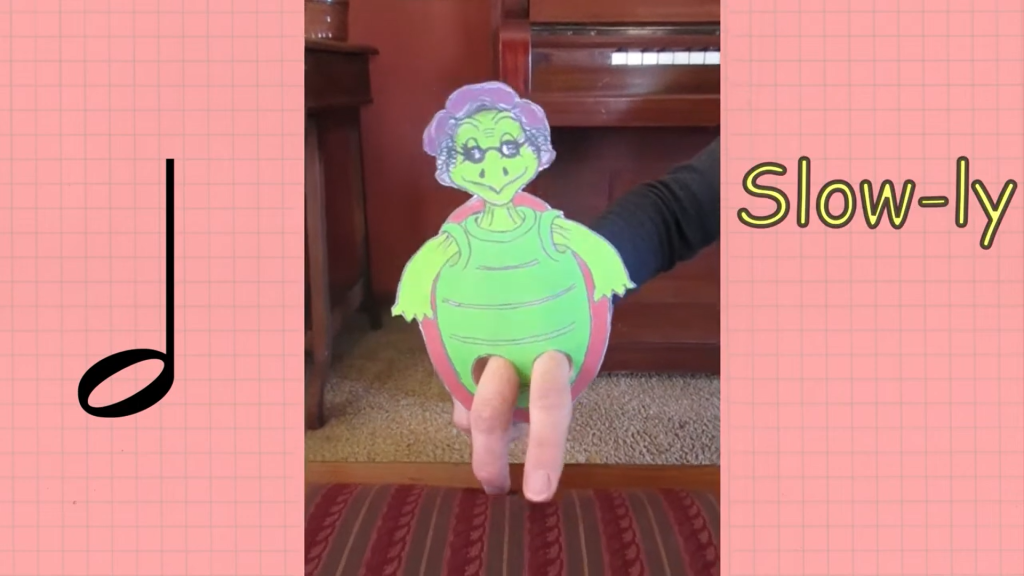
For the Mommy Tortoise (Quarter note) we pretend to be wearing her high-heeled shoes and walk on tip toes with a “Click! Clack! Click! Clack!” to the front of the classroom and back to the seats. As Daddy Tortoise (also Quarter note) we pretend to wear the boots and walk with a “Doof! Doof! Doof! Doof!” to the front and back again.
When it is the turn of the running children, Tammy and Tommy Tortoise (Eighth notes), it is an opportunity to let the kids get rid of some energy. Let them run outside to a specified landmark and then back again to their seats. This they can do while chanting “Running! Running! Running! Running!” (…if they remember to…).
LEARN TO PLAY THESE NOTE VALUES ON THE RECORDER…
… by watching the rest of the “EMW Beginner Recorder LESSON 3”. This includes reading patterns built with all the note values learnt so far. Let the kids read along aloud when the words for the note values are spoken, as well as for the “Too, too, too-oo…”. They can also clap along with the words “Hop! Hop! Dong! …”. On “Dong! _” the hands can swing forward after the clap, like Granny’s leg swings forward after the step. The more the children experience the rhythms in different ways, that is, with words, movement and clapping, the better they will internalize the note values and rhythms. End this lesson by handing out the copy of the piece to practise for next time. This piece is available for free in a link under the video for LESSON 3 on YouTube.
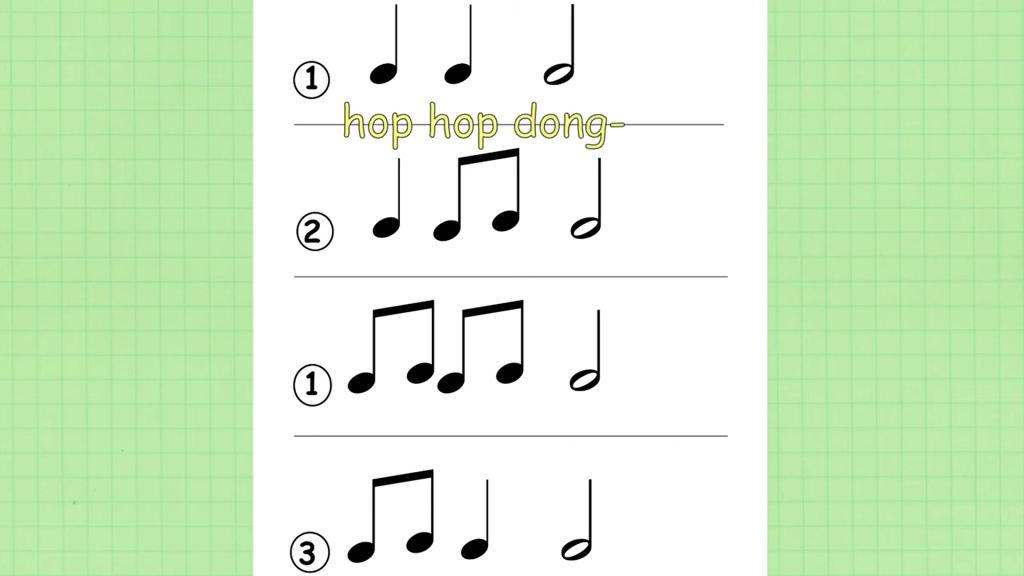
Here is a summary in point form of the above lesson:
-
- Show video:“Mickey Mouse – William Tell vs Turkey in the Straw – by Orlan Charles”
-
- Watch the “EMW Beginner Recorder LESSON 3”. (Let the kids join in with the breathing exercise at 2:50 minutes into the video.)
-
- At the end of the story of the Tortoise family revise the movement for each note value:
-
- Grandpa note (Whole note): each step should be four counts long and can be counted out with a wobbly Grandpa voice: “One, two, three, four!”, while holding on to the aching hip with one hand and an imaginary walking stick with the other hand.
-
- Grandma Tortoise (Half note): step-swing movement while saying with Grannies voice “Slow-ly! Slow-ly! Step-swing, step-swing! One-two, one-two…”
-
- Mommy Tortoise (Quarter note): pretend to be wearing her high-heeled shoes and walk on tip toes with a “Click! Clack! Click! Clack!”
-
- Daddy Tortoise (also Quarter note): we pretend to wear the boots and walk with a “Doof! Doof! Doof! Doof!”
-
- Running children – Tammy and Tommy (Eighth notes): let the kids get rid of their extra energy and let them run outside to a specified landmark, chanting “Running! Running! Running! Running!…”
-
- Watch the rest of the “EMW Beginner Recorder LESSON 3” video, which involves reading rhythm patterns build with the note values learnt so far. Let the kids read along aloud for “Hop! Hop! Dong! _ …” and clap and read along for “Too! Too! Too-oo!”
-
- Play along from screen.
-
- Hand out their own copy of the piece to practise (link found below the video in the description)
FIRST FOLLOW-UP LESSON:
We have put together a Supplementary Pack for the EMW BEGINNER RECORDER LESSON 3, which includes the Tortoise Family and Note Value Cards, which is now available at TpT. These visual aids will be helpful for the following follow-up lesson.
In this lesson we start by acting out the story of the Tortoise family as shown in the video for EMW BEGINNER RECORDER LESSON 3 (This story is now also available on YouTube as a short video here). The supplementary pack does not include pictures of Daddy and Mommy Tortoise’s bedroom, Tammy and Tommy’s bedroom, the Tortoise family kitchen and a picture of a garden, or pictures of flowers for Granny Tortoise to admire. The latter I took from an old calendar. Maybe you have pictures of flowers in an old magazine?
Pictures of the bedrooms can be found in magazines or online. I put up pictures of the Tortoise family parent’s bedroom and children’s bedroom on the one side of the classroom, and the kitchen and garden on opposite walls in the classroom before the lesson. This way the characters can move from one “room” to another with enough space between the “rooms”.
We start in Mommy and Daddy Tortoises’ bedroom, that is, at the picture of their bedroom. First Mommy Tortoise (picture) gets up in the morning to go to the kitchen to make some porridge for breakfast. Let one of the kids hold Mommy Tortoise, so that the teacher’s hands are free to play the beat for Mommy Tortoise’s “Click! Clack!” steps on the claves or rhythm sticks. The teacher and children get into their imaginary high-heeled shoes and walk with a “Click! Clack! Click! Clack!…” all the way to the picture of the kitchen. Stick the picture of Mommy Tortoise next to the picture of the kitchen, including two of the “Click! Clack!” music notes, namely the quarter notes.
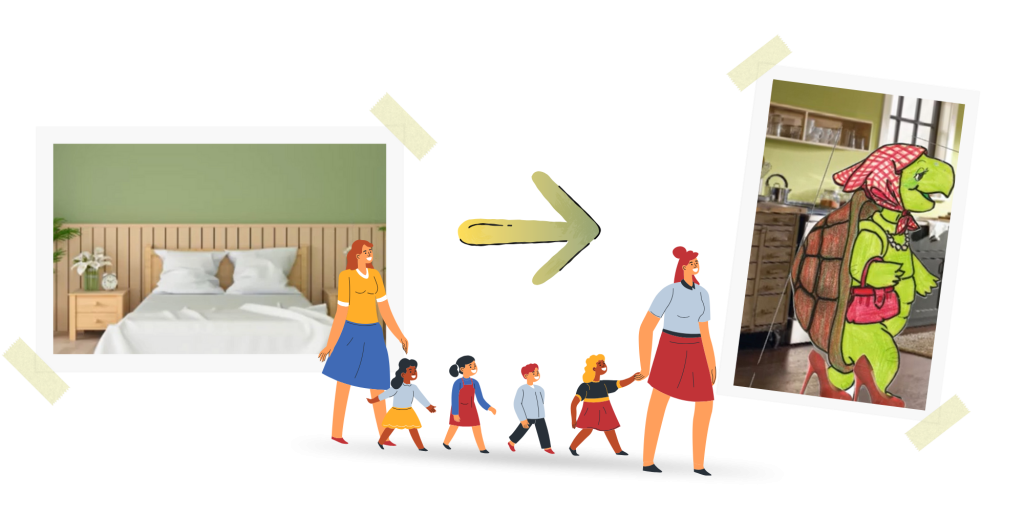
Next we go back to Mommy and Daddy Tortoises’ bedroom, that is, the picture of their bedroom. The second tortoise is Daddy Tortoise, who gets up in the morning to go to the kitchen to eat some porridge for breakfast. Let one of the kids hold Daddy Tortoise, so that the teacher’s hands are free to play the beat for Daddy Tortoise’s “Doof! Doof!” steps on the hand drum or tambourine. The teacher and children get into their imaginary boots and walk with a “Doof! Doof! Doof! Doof!…” all the way to the picture of the kitchen. Stick the picture of Daddy Tortoise next to the picture of the kitchen, including two of the “Doof! Doof!” music notes, that is, two more quarter notes.
Now it is time for Tommy and Tammy Tortoise to get up and go to breakfast, so we go to the children’s bedroom, that is, at the picture of their bedroom. They are hungry and full of energy, so they go “Running! Running!” to the kitchen. Let two of the kids hold Tommy and Tammy Tortoise, so that the teacher’s hands are free to play their “Running” notes on the shakers or maracas, because they are still wearing their house slippers. The teacher and children go “Running! Running! Running! Running…” all the way to the picture of the kitchen. Stick the pictures of Tommy and Tammy Tortoise next to the picture of the kitchen, including two pairs of “Running” notes, that is, two pairs of eighth notes.
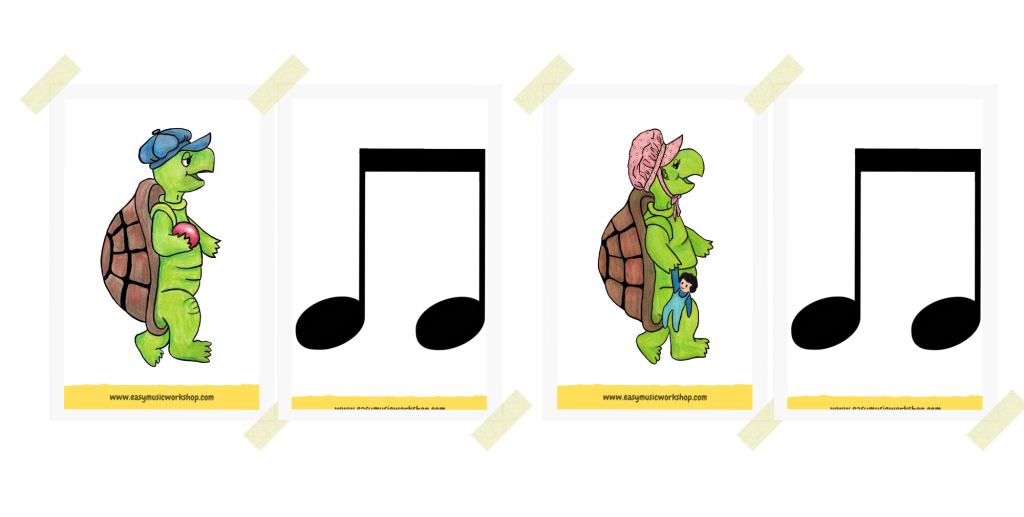
Meanwhile, Granny Tortoise goes for a walk in the garden before breakfast. Everyone heads to the pictures of the garden (or even goes into the actual garden, if there is one close by…). Let one of the kids hold Granny Tortoise, so that the teacher’s hands are free to play the “Slow-ly!” (or “Dong! _” note) on the triangle. The teacher and children place their hands behind their backs and walk with a “Step-swing! Step-swing! Slow-ly! Slow-ly!…” past the pictures of the flowers. Stick the picture of Granny Tortoise next to the picture of the garden and the flowers, including one of the “Slow-ly!” or “Dong!” music notes, that is the half note.
Grandpa Tortoise joins Granny Tortoise in the garden, and he walks very slowly with each of his steps lasting four counts. Let one of the kids hold Grandpa Tortoise while the others hold onto their sore hip with the one hand and the recorder as the top of their walking stick with their other hand and slowly make their way past the flowers counting “1 – 2 – 3 – 4!” per step. The teacher can accompany each “1 – 2 – 3 – 4!” step on a cymbal or gong, that is, with a whole note. When Grandpa Tortoise is tired, stick him next to the pictures of the flowers together with the whole note.
TIME TO DRAW MORE MUSIC NOTES:
After moving to the different note values, the children can now draw the different note values using the worksheets from the SUPPLEMENTARY PACK FOR THE EMW BEGINNER RECORDER LESSON 3 :“Let’s draw more music notes” and “Let’s draw ‘Running’ Notes!”. These two worksheets explain step by step how to draw the whole note (semibreve), the half note (minim), the quarter note (crotchet) and the eighth notes (quavers).
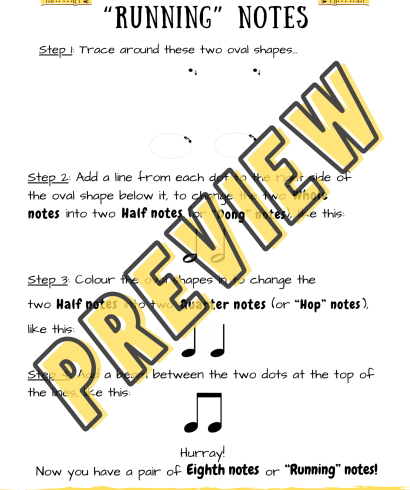
A SONG WITH RUNNING NOTES:
In the SUPPLEMENTARY PACK FOR THE EMW BEGINNER RECORDER LESSON 3 I have included a song with eighth notes called “Running down, running up!” which could be used to conclude this lesson.
The song can be projected onto the screen for all to see and follow at the same time.
Decide on which words to use for the note values. Together with the children you can discuss this. Since we just moved through the story of the Tortoise family, we could go with the words:
“Running! Click! Running! Clack!
Running! Running! Running! Doof!”
Or if you prefer to stick with the word “Hop!” for the quarter note it could read as:
“Running! Hop! Running! Hop!
Running! Running! Running! Hop!”
Then blow without the recorder to the rhythm:
“Too-too Too! Too-too Too!
Too-too! Too-too! Too-too! Too!”
If necessary, remind the children to use the tongue when blowing each note into the recorder.
Revise the fingering: 1, 2 and 3, and then play the song on the recorder as a group, while the teacher points to the notes of the song on the screen as they are played to keep the group together.
Hand out a copy of the song to each child to take home and practise.
Here is a summary in point form of the above lesson:
-
(Have the pictures of the various rooms and for the garden ready and hanging on the walls, as well as the instruments to be used to accompany the family members.)
-
- Act out the story of the Tortoise family to revise the movement for each note value:
- Mommy Tortoise (Quarter note): pretend to be wearing her high-heeled shoes and walk with a “Click! Clack! Click! Clack!” from the bedroom to the kitchen, accompanied by rhythm sticks or claves.
- Daddy Tortoise (also Quarter note): we pretend to wear the boots and walk with a “Doof! Doof! Doof! Doof!”
from the bedroom to the kitchen, accompanied by the hand drum or tambourine. - Running children Tammy and Tommy (Eighth notes): run from their bedroom to the kitchen chanting: “Running! Running! Running! Running!…”, accompanied by a shaker or maracas.
- Grandma Tortoise (Half note): step-swing movement through the garden while saying with Granny’s voice: “Slow-ly! Slow-ly! Step-swing, step-swing! One-two, one-two…”, accompanied by a triangle.
- Grandpa note (Whole note): each step should be four counts long and can be counted out with a wobbly Grandpa voice: “One, two, three, four!”, accompanied by a gong or cymbal.
- Draw the note values of the whole note, the half note, the quarter note and the eighth notes on the worksheets: “Let’s draw more music notes” and “Let’s draw ‘Running’ Notes!”.
- Listen to, speak and play the song “Running down, running up!” from screen.
- Hand out their own copy of the piece to practise
-
SECOND FOLLOW-UP LESSON:
A second follow-up lesson is available in the SUPPLEMENTARY BUNDLE FOR THE EMW BEGINNER RECORDER LESSON. It begins with a breathing exercise, the “Owl” breathing exercise towards the beginning of the EMW BEGINNER RECORDER LESSON 3. A short video of this breathing exercise is now available on the Easy Music Workshop / Recorder Lessons YouTube channel here.
The bundle also includes a worksheet for some experimental composing…
WRITING YOUR OWN MELODY:
In the SUPPLEMENTARY PACK FOR THE EMW BEGINNER RECORDER LESSON, which is available HERE, you will find a worksheet which guides the kids through writing their own melody to a given rhythm, using only the fingering 1, 2 and 3. When they are done the children can then play the melodies they wrote to the teacher and the class.
By cutting their melody into strips they can rearrange the strips to build different melodies as suggested at the end of the video for LESSON 3. It is amazing how many variations one can get from a group of children.
I hope that you have found these ideas for teaching note values to young kids helpful. If you have found this post helpful, then you can find more information about this topic in the blogpost on using words to teach note values and rhythms. You can find it here.
Every teacher has a different way of teaching music concepts. I would love to hear how you teach note values to your music students. So, if you have some great ideas to share, let us know in the comments section below.
Kind regards
Elisabeth
